About Me:
Hey guys, my name is Arnav Jalan and I am a student in Dr. Cooke’s English 101: The Personal is Public Expository Writing class. Currently, I am a freshman here at Emory University and plan to major in Mathematics and Economics and possibly minor in Computer Science.
This reflective portfolio revolves around two aspects of my writing I feel I have improved on throughout the course of this writing class. Each aspect consists of least three artifacts that are used as examples to highlight how far each aspect had developed over the course of the semester. These artifacts consist of initial drafts, in-class writing assignments, and select sentences and paragraphs and can be classified as the build-up to the what is known as the ‘featured’ artifact. According to me, the ‘featured’ artifact is a work that showcases the best of my skills and abilities as a writer. The artifact showcases everything I have learnt from this writing class and clearly highlights my development as a writer. The featured artifact not only includes the two aspects of my writing that will be discussed below but also demonstrates my overall growth as a writer.
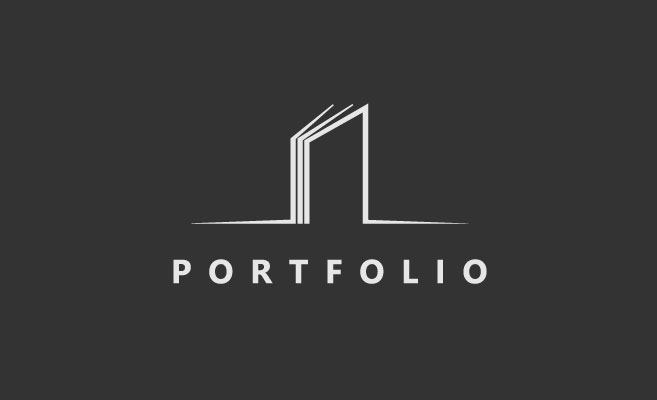
During the course of this semester in the English 101-015 Expository Writing course I feel that I have improved greatly in two aspects of my writing style. The first is the fluidity and Continuity of my sentences and the second is the overall Structure and Organization of my works. Both aspects ultimately improve my ability to develop my ideas in a coherent manner.
I. Continuity and Flow: The Known-New Contract
A writer’s skill in creating fluid sentences that create a sense of continuity can be measured by his ability to effectively utilize a concept known simply as the ‘Known-new Contract’.
According to Carnegie Mellon University’s Global Writing Center:
A sentence can be divided into two parts: a topic and a stress position. The topic is the first part of the sentence and the stress is the last.
In the topic position, readers expect to understand what the sentence is about and try to connect the sentence to what they have already read. On the other hand, in the stress position, readers expect to see new and important ideas and information.
The Known-New Contract suggests that comprehension is increased when the topic position of a sentence contains information that links back to what the reader already knows and the stress position contains new information that the writer wants to emphasize.
Initially, my ability to effectively use the Known-New Contract was much worse than I had thought. Earlier on in the semester my writing was not as organized as the contract would want it to be and I could not develop my ideas in a coherent manner. The following lines have been taken from my first in-class writing prompt and can be used to gauge my ability to use the Known-New Contract.
Artifact 1: In Class Writing 1
In class writing assignments are structured assignments guided by topic prompts and guidelines regarding style, length and other foci. This particular in class writing assignment was centered around a famous speech delivered by August Wilson known as The Ground on Which I Stand. I was first asked to respond to Wilson’s speech and then present a write up on the following questions:
i. What was your motivation or responding to Wilson the way you did?
ii. Why were you motivated this way (what is it about the way we live now that might have motivated you?
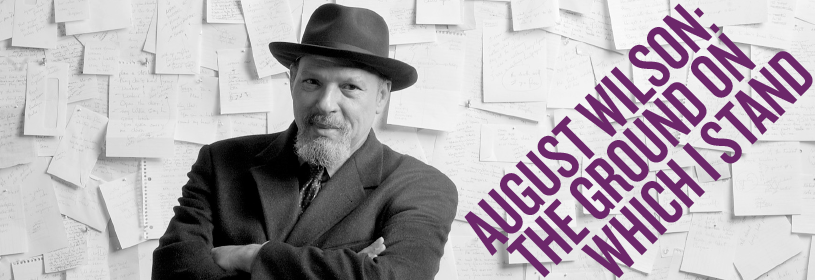
Below are a couple of sentences extracted from my writeup.
“He talks about his motivation to participate in the Black Power Movement in the 1960s and cleverly uses imagery as a means to make the audience picture in the heads the state of the African Americans when they were being transported in slave ships. He talks about how African American Culture is often neglected and how it is crucial to understand others arts, history and culture and not leave them in the shadows. However, I do not believe in the fact that Race is the single most defining character of an individual.”
To access the complete assignment click the given link: Writing Prompt 1_English 101_Arnav Jalan. The quoted lines have been highlighted along with other lines that act as examples of my ability to use the Known-New Contract at that point of the semester.
The string of sentence presented above have absolutely no flow or continuity through them. Each sentence sounds like a statement and does not follow any of the guidelines provided by the Known-New Contract. An analysis of each sentence has been provided below to demonstrate the breach in contract.
First sentence : The topic in the first sentence states that August Wilson talks about his motivations to join the Black Power Movement. The stress in the sentence expands to how August Wilson makes use of imagery to make his audience picture the state of African Americans when they were being transported on slave ships.
Second sentence : The topic in the second sentence does not, however, link back to the stress introduced in the first sentence. The topic states that August Wilson talks about how African American culture is often neglected. This is clearly very different from the ideas developed in the first sentence. The stress in the second sentence is the idea that August Wilson thinks it is crucial to understand other’s art, history and culture and not leave them in the shadows.
Third sentence : The topic in the third sentence does not link back to the stress of the second sentence in any way. The second sentence develops ideas of recognizing the art, history and culture of others but the topic of the third sentence makes a sudden jump to my opinions about race and identity. The stress in the third sentence is the idea that people should not be defined based on their race. However, this is a very subjective opinion and hardly relates to the ideas introduced prior to this sentence.
As seen from the analysis above, the quoted lines do not make use of the guidelines set by the Known-New Contract. The first sentence develops an idea but the successive sentence has little to no link to the ideas developed in the sentence prior to it. This pattern is seen throughout the assignment.
As time progressed, I became more adept in using the Known-New Contract. To showcase this improvement, I will quote lines from another in-class writing assignment given to me later in the semester.
Artifact 2: In Class Writing 4
The fourth in-class writing assignment was focused on Paul Robeson: a famous American bass singer and actor.
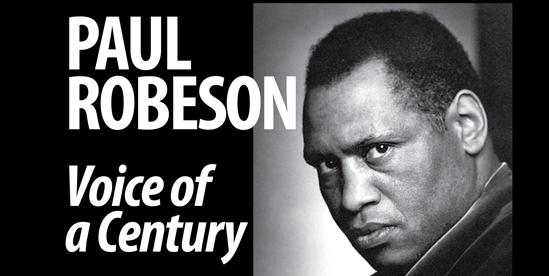
We were told to comment on some of Paul Robeson’s achievements and whether they were still relevant in today’s world. The quoted lines are from the first few lines of the introduction of the prompt.
“Paul Robeson was a beloved international figure who spoke against racial injustice and was involved in world politics. He was one of the first African American men to play serious roles in the White American Theatre. He performed in a number of films as well, including the re-make of ‘The Emperor Jones’. He used his popularity as an actor to rise to the pedestal of a national symbol and a cultural leader in the war against fascism abroad and racism at home.”
To access the complete assignment click the following link: writing-prompt-4_english-101. The quoted lines have been highlighted along with other lines act as examples of my ability to use the Known-New Contract at that point of the semester.
First Sentence : The topic in the first sentence is Paul Robeson. The stress in the first sentence is that Paul Robeson was an international figure who spoke against racial injustice and was involved in world politics.
Second Sentence : The topic in the second sentence continues with Paul Robeson. So, in relation with the first and second sentence, the topic of the second sentence is somewhat related to the stress introduced in the first sentence. Though the stress in the first sentence does not specify Paul Robeson having an acting career the topic in the second sentence does introduce this fact. For all guidelines of the Known-New Contract to be met, it would have been better if the first sentence also a few words highlighting Paul Robeson as an actor.
The stress in the second sentence is the information that Paul Robeson was one of the first African American men to play any major or serious roles in White American theatre.
Third Sentence : The topic in the third sentence is has a clear link to the stress developed in the second sentence in that both are concerned with Paul Robeson’s acting and performing career. The topic in the third sentence tells readers that Paul Robeson performed in numerous films. Meanwhile, the stress in the third sentence provides its readers with new information that Paul Robeson also performed in the re-make of the famous film ‘The Emperor Jones‘.
Fourth Sentence : The topic present in the fourth sentence revolves around Paul Robeson’s popularity as an actor. This has a clear link to the stress in the third sentence. The third sentence plays the role of establishing the fact that Paul Robeson was popular. This was achieved through stating that he has participated in numerous films. However, the third sentence ultimately achieves this goal by providing the information that Paul Robeson also performed in the re-make of ‘The Emperor Jones’. By providing the name of a popular re-make, the sentence makes its readers gauge Robeson’s popularity. So, using the ideas developed in the third sentence, the fourth sentence gives readers crucial information on how Paul Robeson used his popularity as an actor to fight in the war against racism and fascism.
As seen from the analysis above, my ability of using the Known-New Contract had developed greatly as time progressed. When compared to the quality of the first in-class writing, the quality of this in this assignment far exceeds that of the first one. After reflecting on the feedback given to me on some of my previous works, I improved greatly on this ability of using the Known-New Contract. However, though the quoted lines made a much better use of the Known-New Contract, there still lacked of flow between each sentence. There still lacked a certain sense of continuity.
After realizing that I still needed to further improve on this skill, I decided to practice it on the the Narrative Essay assignment.
From watching tutorials on YouTube to countless revisions and edits, I believe that this narrative essay assignment showcases clear use of the Contract as well as excellent transition between each sentence. Through this narrative essay, one can not only observe significant improvement in my ability to use the guidelines given by the Known-New Contract but also improvement in my sentence structure, grammar and syntax.
Artifact 3: Narrative Essay
This assignment was written and submitted towards the end of the semester (November 20th to be exact). I had great fun working on this assignment because I was not restricted by the usual guidelines or rubrics found in previous assignments. The task was simple : I had to pretend I was an impartial visitor at my curated exhibit. I had to describe how I moved from object to object in a first-person point of view. I discussed about thing such as where his eyes were drawn to, what caught his attention and why etc.
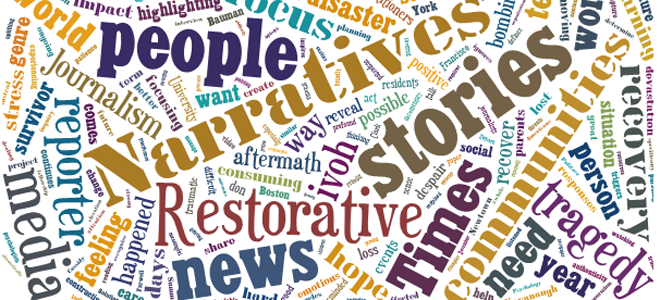
Below are some lines quoted from the narrative essay. According to me, these are some of the best sentences in the essay.
“After introducing August Wilson, the curator then used an interesting example from the play Fences written by the author. The example revolved around Troy Maxson, the primary protagonist, and his son, Cory Maxson. Troy Maxson was a single head of family who struggled to provide for his family. Even though Troy was a great baseball player, he could not progress in this career path due to the presence of racial discrimination in the field of professional sports in that era. This leads a frustrated Troy to believe that racial discrimination against the African American community was not going to stop anytime soon.”
“The conclusion consisted of a culmination of a story that started with one simple sentence: “African American history during the late 1950s is filled with movements and struggles that were pivotal for African Americans to gain equal footing with people from other, more dominant, races” and ended with a deep understanding of the mentality of African Americans in the 1950s and how the prolonged discrimination against them affected their day to day activities. The conclusion not only very clearly and articulately describes how the mentality of African Americans was affected by the prolonged discrimination against them, but also generalized it to all communities that face discrimination in the world today.”
I feel that this assignment showcases the pinnacle of my development in my skills and abilities to create sentences with fluidity and structure. In order to successfully complete the assignment, I not only used the Known-New Contract but also made use of skills such as persuasion, imagination, rhetoric and imagery. Along with use of various literary and stylistic devices, this assignment also consisted of a seamless transfer from sentence to sentence. Each sentence had a clear topic and stress that had clear links with successive sentences and ideas. and This narrative essay was not just any writeup; it was a story. Through this story, my reader could easily place his or her self in my shoes and visit the curated exhibit from their bedroom.
To access the narrative essay click the following link: Narrative Essay_Final_ARNAV
II. Structure and Organization : Intricate Idea Development
The structure and organization of a writeup plays an important role in deciding what the writeup is trying to convey to its readers. An ill-structured assignment may end up presenting an incorrect idea. Poor development of ideas leads to confusion. Furthermore, unorganized idea development can also often lead to hesitation as readers may not be excited to read an unruly assignment.

Organization and structure of ideas had never been a strong point for me in the earlier days of the semester. This is clearly evident by my second draft for the introduction for the proposal of the Curated Exhibit assignment.
Artifact 1: Second Draft for the Proposal for the Curated Exhibit
The curated exhibit assignment gave me the opportunity to curate an online exhibit. I had to chose a minimum of five artifacts from the Billops-Hatch Archives at the Stuart A. Rose Library and the Emory Academic Search Complete online database. The theme for the curated exhibit had to be developed from an initial artifact. For the purpose of this assignment, the initial artifact had to be chosen from a variety of play scripts written by famous African-American writers.
My curated exhibit evolved from the play Fences written by famous writer and poet August Wilson. The theme and title of my exhibit was: Prolonged Discrimination against a community: Building fences within the community and the Cause for Mistrust and Disunity.
However, before I could go ahead with curating the exhibit itself, I was required to submit a formal proposal containing the following sections: “introduction” (thesis), “statement of the issue” (why your project is important), “objective” (what your hope your research accomplishes/contributes to public life), and an annotated bibliography.

The second draft of the introduction to my proposal consisted of great ideas placed in a very disorganized format. The introduction was to be used as a tool to introduce its reader to the central theme of the curated exhibit. To accomplish this, I begin with a short introduction on African American history in the 1950s. However, I then immediately jump to my chosen play script and begin describing its looks and features. You can notice that I begin with one idea but then immediately move on to another idea without expanding on the first. Similarly, there is no connection between the second and third paragraphs because the second talks about fences while the third suddenly switches to August Wilson’s writing style.
To access the complete assignment click on the following link: Curated Exhibit_Proposal_Draft 2_ARNAV
This hinders the reader’s experience and leaves the reader confused as to what the introduction is trying to convey. Considering the fact that the introduction is regarded as one of the most important aspects of a proposal, changes were definitely needed. After working on the feedback given to me and after self-evaluating the introduction, I perfected the introduction.
Artifact 2: Final Draft for the Proposal to the Curated Exhibit
After multiple revisions and edits, I feel that I had managed to craft a much improved proposal for my curated exhibit assignment. The proposal was well structured: it provided a clear and concise introductory paragraph, moved on to the statement of purpose for the exhibit, then narrowed down to the objective of the curated exhibit and culminated with a plan of action and an annotated bibliography. There is a clear development of ideas throughout the proposal.
However, after receiving comments on my final draft of the proposal, I realized that my skill in organization and structure was still not at the level I would want it to be. There were instances where there certain sentences did not mesh with the rest of the paragraph. For example, in paragraph one of the introduction, the description of the artifact used (lines 6 – 10, highlighted in the link provided) seemed to divert from the topic initially introduced in the paragraph. Also, paragraph four in the introduction seems very out of place when compared to the previous paragraph. I realized that the paragraph would have made more sense if it was merged with the following paragraph because the following graph draws conclusions from the play Fences using August Wilson’s style of writing.
So, as seen from the final draft of the proposal for the curated exhibit assignment, I had definitely improved in my ability to structure and organize my ideas but there were still certain flaws present in the assignment.
To access the assignment click on the following link: Curated Exhibit_Proposal_FINAL_Arnav Jalan
The flaws present meant I knew I still had to work on developing my ideas in the most coherent manner possible. This meant hitting the library again and working on possible approaches I could use to solve the problem. The solutions I thought of have been incorporated to my curated exhibit assignment.
Artifact 3: The Curated Exhibit
As described earlier in the portfolio, the curated exhibit assignment gave me the opportunity to curate an online exhibit. The quoted lines below have been extracted from the objective paragraph of my proposal for the curated exhibit and briefly describes what the objective of the exhibit was.
“The objective of the curated exhibit was to use August Wilson’s views on racial discrimination in the 1950s to highlight and create awareness on how discrimination caused disunion and separation within the community being discriminated. This disunion is caused when a fair number of people start to believe that the discrimination against their community will not end in the near future. This leads to fights and conflicts within the community and this ultimately causes further dissension. In the play Fences, this disunion takes place in the Maxson family with Troy Maxson being the one to believe that this discrimination will not end while his son, Cory Maxson believed otherwise.”
For the purpose of this assignment, Microsoft PowerPoint was used as the exhibit designing tool. Designing an exhibit meant that I had the opportunity to be extremely creative and unique with the placement of my objects and artifacts. Furthermore, I could choose background colors, text fonts, font sizes and themes.
While designing the exhibit I realized that this was the perfect assignment to improve on my skills of structuring and organizing my works and I feel that I have definitely done so.
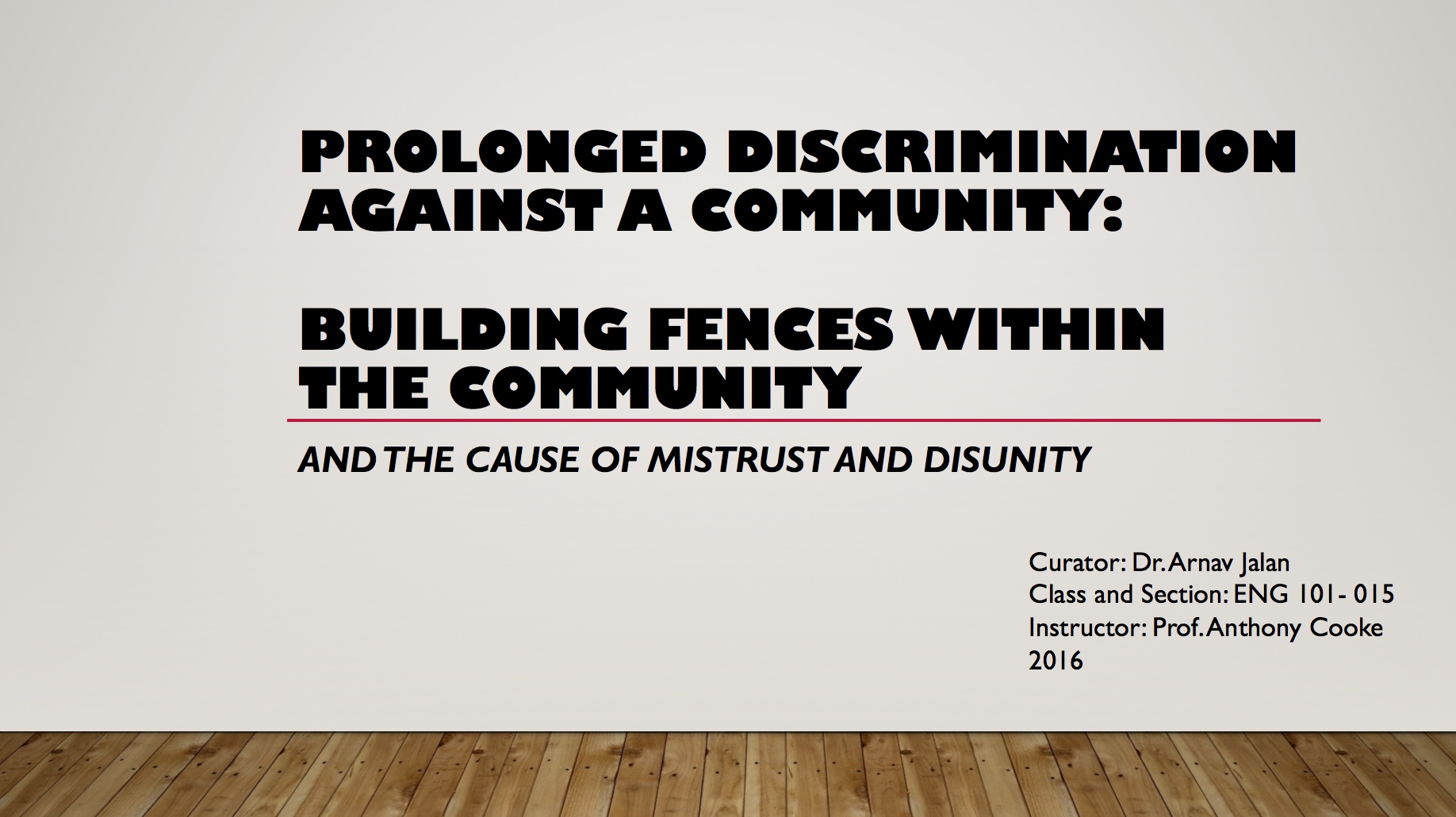
Firstly, I chose a theme that had a solid gray background with a polished wooden floor. This let out a modern feel that quietly contradicted the historical theme of the exhibit. Next, I chose a very modern font (Gill Sans MT) to further enhance the modern look and feel.
Then came the presentation of the artifacts. If you didn’t notice before, in slide three of the presentation, I made the caption text boxes slightly exceed the space provided by the theme. At first, one would think this was a mistake but I had done this intentionally to create a 3D like effect. The goal was for the viewers to feel as if the photos and captions were floating and this added another dimension to my exhibit. This technique is repeated in other slides as well.
Next, in slide five of the presentation, I made sure that the play script Fences was placed in a frame to give the effect that it was in a glass container of some sort. The reason behind this was that, in actual exhibits, most artifacts would be in containers and not be accessible by the audience.
Next, from slide eight (pictured below) to slide ten, a very particular format of object orientation is followed. Each slide contains two pictures with their appropriate captions. What one may not notice when they first look at these slides is the fact that each slide is in chronological order. Also, another important piece of information is that, in every slide, there is one instance where there is discrimination against African Americans and another where African Americans are treated as equals by the rest of society. This was done in order to achieve the objective of the
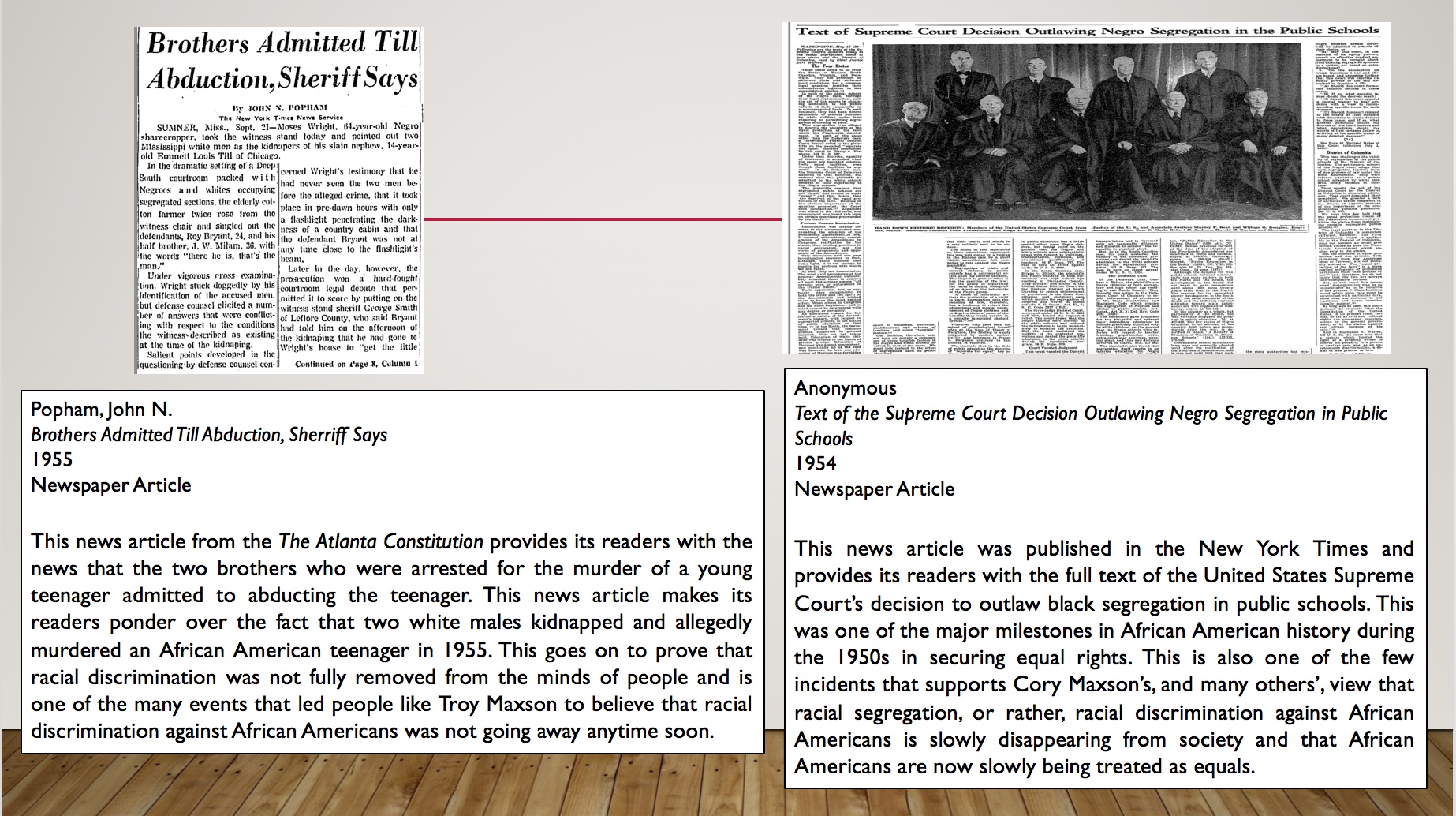
curated exhibit. The purpose of the exhibit was to show that, during the 1950s, there were instances where African Americans were treated as equals and instances where they were racially discriminated against. These artifacts cleverly led back to the initial example of Troy
and Cory Maxson from the play Fences. During the 1950s, a large number of African Americans started to believe that the racial discrimination against them would not stop anytime soon. This was reinforced by the events such as the incident of Emmett Till (slide eight and nine) and the incident where Rosa Parks was demanded to give up her seat in the bus (slide 10). However, on the other hand, there were those African Americans who believed that they were slowly being treated as equals by the rest of society, thus causing the disunity and divide within the community. This belief was reinforced by events such as Hank Aaron leading the Braves to the World Series (slide 9) and the Supreme Court outlawing racial segregation in schools (slide 8).
In conclusion, this curated exhibit showed the what I believed to be the best of my ability to organize and structure and assignment.
To access the assignment click on the following link: Curated Exhibit_Final_ARNAV
Conclusion
In conclusion, throughout the course of this semester, I have learned to form intricate sentences that create establish continuity and flow. From having little to no experience in doing so before, evident from my first in-class writing assignment, I now feel that I have almost perfected the art of developing such sentences, as seen from my narrative essay. Continuity and flow in my sentence insured coherent idea development.
Similarly, at the beginning of the semester, I lacked the ability to structure my works in a meaningful manner. This led to poor idea development, evident from the second draft of my proposal to the curated exhibit. However, through embracing the fact that writing is a process I managed to grasp how to better develop my ideas through structuring and organizing my works in a specific and orderly fashion. Only through multiple drafts, revisions and assignments as a whole could I achieve this. My curated exhibit is a clear example of this feat.
Up until now you have witnessed the development in two of my writing abilities. The first being the continuity and flow of my sentences and the second being the organization, structure and the development of ideas in my works. However, many you may be wondering… “but where is the featured assignment / artifact? “
Before I answer that question, let me once again state what the featured artifact is. The ‘featured’ artifact is one assignment / project done this semester that, I feel, is my best work. This featured artifact consists of everything I have learnt throughout the semester, whether it be the Known-New Contract or Idea Development. So, after carefully analyzing each and every piece of writing I have done this semester, I finally chose my featured artifact.
I will keep you in suspense no longer, my featured artifact is ….. this reflective portfolio. I feel that this portfolio very clearly shows my improvements as a writer. Whatever I have learnt in this expository writing course is demonstrated in this reflective portfolio assignment; whether it be the Known-New Contract, the flow between sentences or the structure and organization of the assignment. I feel that this assignment is the culmination of everything I have learnt in this course. From my first in-class writing to my narrative essay; my early drafts of my proposal to the final curated exhibit; my growth in the two aspects discussed above culminates in this piece of writing.
In this portfolio,
Each and every idea and concept discussed in this portfolio is clearly introduced, developed and organized in such a way that it makes you feel that you are reading a story.
Lines extracted from assignments and drafts are quoted, presented in italics and have a different font color to differentiate it from the rest of the text.
Each hyperlink used for the purpose of this portfolio is clearly labelled and opens in a new tab so that readers do not have to unnecessarily navigate back to this page.
Images have been structured and oriented in certain ways that enhance reader experience.
Every sentence in each paragraph of this portfolio makes clear use of the Known-New Contract and creates a sense of fluidity. Every sentence is clearly structured so that they carry the idea introduced in the preceding sentence. Furthermore, every sentence is (according to my instincts) short, concise and to the point with no unnecessary wordage.
While writing this portfolio, I feel that I truly embraced the fact that writing is a process. I began the portfolio with brainstorming and taking notes, gathering information (in this case, artifacts) and outlining. Next, I moved on to drafting. During drafting, I translated my ideas from thoughts to sentences and paragraphs. The objective here was to clearly explain, support and connect the ideas. After drafting, I began revising the portfolio. While revising, I thought about questions like “Is the organization of my work effective?”, “Are there any specific key terms that need to be defined for the reader?”, and “Will the reader be able to understand the message this portfolio is wanting to convey?”. After I was satisfied with the answers to the questions, I began refining my prose. I wanted to make each sentence as concise and accurate as possible. While keeping it concise, I also had to make sure that the connection between ideas was clear and explicit. Finally, I reached the editing stage. At this point, I was content with the information in the portfolio. I used the editing stage to check for things like grammar, spellings, and mechanics. This was the final stage of my portfolio.
Ultimately, what you have seen and read is the best of all my works.
Thank You and Sincerely
Arnav Jalan
Reflective Letter
Dear Portfolio Assessment Committee,
I am writing this letter to highlight that I have achieved all the learning outcomes and course requirements of my English 101 – The Personal is Public Expository Writing Course. These learning outcomes and requirements were achieved through successfully completing various assignments and projects throughout the course of this fall semester. Even though this writing course focused on and made extensive use of African American arts and culture to introduce the different ways in which personal expression eventually intersects with broad historical concerns, I feel that I have developed my skills and abilities as a writer as well.
The first learning outcome I feel I have achieved is ‘Rhetorical Composition’. I feel that, through this course, I learnt how to grab an audience’s attention using a wide variety of methods and approaches. In fact, rhetorical situations were a very important of this course’s curriculum. As a part of our course, we learnt about famous writer and poet August Wilson and how his various plays and speeches captivated their audience’s attention. Furthermore, I also composed assignments and works across various genres such as first person narrative, a curated exhibit using PowerPoint presentation and the reflective portfolio using WordPress.
Artifact three under the ‘Organization and Structure’ section of my portfolio is my curated exhibit. The curated exhibit gave me the opportunity to be extremely creative and unique with the placement of my selected objects, captions and artifacts. Not only object orientation but also fonts, colors, sizes and themes were given extreme importance in this assignment. The purpose of this assignment was to curate an exhibit to convey a very specific theme to an audience. This meant that my exhibit had to visually pleasing in order to catch my audience’s attention. I accomplished this through clever placement of my artifacts, captivating themes and text that sparked curiosity.
Artifact three under the ‘Continuity and Flow: The Known-New Contract’ section is my Narrative Essay assignment. This assignment had a very clear objective: I had to pretend that I was an impartial visitor to my curated exhibit (described above) and write down, in a first person point of view, my experience of walking through the exhibit. For the purpose of this assignment, we were told to imagine if our exhibit was not a PowerPoint presentation, but rather, an actual exhibit at our very own Woodruff Library here at Emory. The goal was to make my readers imagine what the exhibit looked and felt like. I wanted my readers to feel as if they were walking through the exhibit themselves. To accomplish this task, I had to delve into every little and intricate detail possessed by my exhibit. I went to great lengths describing each and every aspect of my exhibit: the colors, themes, font, and orientation of each and every artifact and caption. I also made sure to include sentences of how I felt, including times when I ran out of breadth, in order to make sure that my readers could also gage the sheer size of the exhibit. To achieve the goals of this assignment, I made use of several literary and stylistic devices including rhetoric and imagery.
The next outcomes I feel I have achieved are ‘Critical Thinking and Reading Resulting in Writing’ and ‘Locate and Integrate Archival Material into Writing and Multimodal Projects’. Throughout this course, I had the opportunity to undertake scholarly inquiry and research to develop ideas to be used in my assignments. For example, artifact two in the ‘Structure and Organization of my Works’ section of my portfolio is the final draft of my proposal for my curated exhibit assignment. This proposal made use of various scholarly articles to synthesize and produce the theme for my curated exhibit. Through this assignment, I was able to develop my abilities to craft an argument and incorporate ideas from other’s writings. Firstly, my proposal was centered around the play Fences by August Wilson. The theme was directly derived from the play itself, however, I lacked certain proof to substantiate my claim. So, after scanning through various scholarly articles and peer-reviewed journals, I found the proof I was looking for to go ahead with the theme for the exhibit. Secondly, Dr. Cooke made sure that this assignment should include an annotated bibliography section. Through the annotated bibliography, I learnt correctly cite and use information from other’s works. So, for the purpose of this assignment, I made of use of various primary and secondary sources. Next is the curated exhibit itself. The goal of the curated exhibit was to use August Wilson’s views on racial discrimination in the 1950s to highlight how discrimination caused disunion and separation within the community being discriminated. To accomplish this task, I had to use various artifacts from the 1950s, along with appropriate captions, to showcase in the exhibit. These artifacts were found through sources such as the Robert Langmuir African American Photograph Collection at the Rose Library, the New York Times Historical Database and DiscoverE. I made extensive use of archival materials in this assignment.
The fourth and final outcome I feel that I have achieved is ‘Writing as a Process’. One aspect that made Dr. Cooke’s class unique was that he always stressed on the fact that writing was a process. Through his teaching I understood that an assignment can only be successfully completed if it has been through multiple edits and drafts. Each and every assignment I have written as a part of this expository writing course has been subject to various revisions and edits. Each assignment in this course was a product of an initial draft, several intermediate drafts, and finally a final draft that was ultimately turned in. Furthermore, I also took part in in-class peer review sessions. These sessions presented me with the chance to critique my peer’s work and provide meaningful and helpful feedback while receiving feedback from my peer on my own work as well. Having a fresh pair of eyes go over my work helped me identify areas of improvement I would have otherwise missed and this helped me grow as a writer as well. This further highlighted the idea that writing was a process. Finally, I had to complete three unique diary entries through which I had to opportunity to reflect on my writing, assignments the peer-review and evaluation sessions. Looking back at what I had done throughout the semester, I could not help but realize that it was a part of a process.
In conclusion, The Personal is Public writing course helped me grow as a writer. Through this course I learnt various things that have helped me develop my skills and abilities. In-writing exercises (artifacts one and two in the Continuity and Flow: The Known-New Contract section of my portfolio) enhanced my ability to think on the spot and write a response to a given set of questions. Furthermore, I have learnt to write in different formats and genres, I have realized that writing is a process and that a work can only be perfect if it has undergone multiple revisions and edits and finally, I have learnt to develop and synthesize ideas and also use others ideas with the correct citations.
Sincerely
Arnav Jalan
To access the reflective letter as a PDF Document, click on the following link: Reflection Letter_Arnav Jalan_Final
